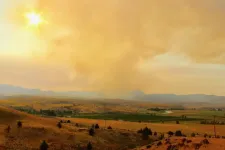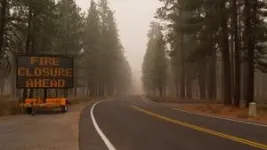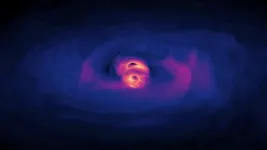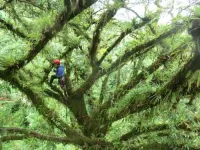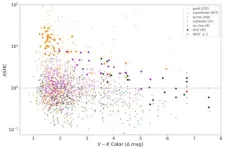(Press-News.org) CORVALLIS, Ore. – A newly enhanced database is expected to help wildfire managers and scientists better predict where and when wildfires may occur by incorporating hundreds of additional factors that impact the ignition and spread of fire.
“There is a tremendous amount of interest in what enables wildfire ignitions and what can be done to prevent them,” said Erica Fleishman, an Oregon State University professor. “This database increases the ability to access relevant information and contribute to wildfire preparedness and prevention.”
The Fire Program Analysis Fire-Occurrence Database was developed in 2013 by the U.S. Forest Service and since been updated five times. It incorporates basic information such as ignition location, discovery date and final wildfire size.
The revised database now includes many new environmental and social factors, such as topography and vegetation, social vulnerability and economic justice metrics, and practical attributes such as the distance from the ignition to the nearest road.
In addition to aiding on-the-ground firefighters and managers, the database could also help power companies evaluate short-term risk when deciding whether to implement a public safety power shutoff or land management agencies determine whether to reduce access to public lands or restrict campfires during certain times of year, Fleishman said.
“There seem to be a lot of policies that are guided to some extent by intuition or emotions rather than by a large body of evidence,” she said. “These data present one way to increase the objective evidence to consider when making those decisions.”
The team, including Fleishman, and led by Yavar Pourmohamad, a doctoral student at Boise State University, and Mojtaba Sadegh, an associate professor at Boise State, added nearly 270 additional attributes. The database now includes information on 2.3 million fires in the United States from 1992 to 2020.
“This provides a considerably deeper understanding of the individual and compounded impact of these attributes on wildfire ignitions and size,” Pourmohamad said. “It also identifies the unequal effects of wildfires on distinct human populations and ecosystems, which can, in turn, inform efforts to reduce inequities.”
Information from the database can also be incorporated into artificial intelligence and machine learning models that explain drivers of past fires or project likelihoods or effects of future fires, said Fleishman, who is affiliated with OSU’s College of Earth, Ocean, and Atmospheric Sciences and also directs the Oregon Climate Change Research Institute.
“It’s amazing what you can infer when you have the computational capacity and this much information,” she said. “You can ask a lot of questions that inform different actions in different places and to understand what is associated with wildfire ignitions and fire effects.”
A paper outlining the database was recently published in the journal Earth System Science Data.
Other co-authors of the paper are Eric Henderson and Sawyer Ball of Boise State; John Abatzoglou, University of California, Merced; Erin Belval, Karen Short, Matthew Reeves and Julia Olszewski, USDA Forest Service Rocky Mountain Research Station; Nicholas Nauslar, National Weather Service Storm Prediction Center; Philip Higuera, University of Montana; Amir AghaKouchak, University of California, Irvine; and Jeffrey Prestemon, USDA Forest Service Southern Research Station.
The research was supported by the Joint Fire Science Program, a program of the U.S. Forest Service and U.S. Department of the Interior.
END
Researchers enhance tool to better predict where and when wildfires will occur
2024-07-22
ELSE PRESS RELEASES FROM THIS DATE:
A new drug target identified for diseases associated with leukemia-causing virus
2024-07-22
HERSHEY, Pa. — A team of researchers from Penn State College of Medicine found a new target for treating diseases associated with human T-cell leukemia virus type 1 (HTLV-1). They determined that blocking a class of enzymes called kinases, which regulates cellular functions, leads to cell death caused by the degradation of Tax, a protein essential for viral gene expression, viral transmission and survival of cells infected by HTLV-1. The team published the findings in Nature Communications.
HTLV-1 is a retrovirus — a type of virus that hijacks a cell by inserting ...
Astrophysicists uncover supermassive blackhole/dark matter connection in solving the ‘final parsec problem’
2024-07-22
Researchers have found a link between some of the largest and smallest objects in the cosmos: supermassive black holes and dark matter particles.
Their new calculations reveal that pairs of supermassive black holes (SMBHs) can merge into a single larger black hole because of previously overlooked behaviour of dark matter particles, proposing a solution to the longstanding “final parsec problem” in astronomy.
The research is described in Self-interacting dark matter solves the final parsec problem of supermassive black hole mergers published this month in the journal Physical Review Letters.
In ...
Can we predict who will develop migraine headaches?
2024-07-22
A migraine is not just a bad headache. It is a much-dreaded part of a neurologic disorder that has an array of possible symptoms, including pulsating cranial pain, waves of queasiness, bouts of vomiting, and hypersensitivity to light and sound. They frequently materialize unannounced and at the most inopportune of moments.
Pubescent girls with a family history of migraine headaches are especially vulnerable — yet there remain many unknowns regarding the who, when and why of the disorder. Hadas Nahman-Averbuch, PhD, a scientist at Washington University School of Medicine in St. Louis with expertise ...
On the origin of academic traditions — and some alternatives for debate
2024-07-22
(Santa Barbara, Calif.) — The field of science aims to be objective, repeatable and justified in its choices and methods. These principles are what distinguish accepted scientific findings from pseudo-science. Yet the experience of learning and working in the field of science, including graduate school activities and scientific conferences, might not always follow the same principles. These practices and gatherings of scientists may be just as organic and random as evolution.
Have the traditions of science — rituals of poster presentations and tenure positions — evolved by chance? ...
Tropical plant species are as threatened by climate change as widely feared, study confirms
2024-07-22
PROVIDENCE, R.I. [Brown University] — Brown University biologists who set out to better understand the effects of climate change on plant species in tropical mountain regions found that even small variations in temperature and moisture can have massive impacts, threatening not only plants that live there, but also the ecosystems they support.
Emily Hollenbeck, who conducted the research while earning her Ph.D. in ecology and evolutionary biology from Brown, made the discoveries through a series of laborious yet informative experiments conducted in the Monteverde mountain ...
SNIS 2024: New study shows updated stroke evaluation protocols increase patient access to lifesaving stroke treatment
2024-07-22
COLORADO SPRINGS, Colo. — Changing standard procedures for evaluating and treating patients with suspected stroke has led to improved access to lifesaving stroke surgery across the state of Delaware and should inform triage and treatment nationwide, according to research released today at the Society of NeuroInterventional Surgery’s (SNIS) 21st Annual Meeting.
In “Direct From the Field Bypass to CSC Improves Timeliness and Likelihood of Thrombectomy for Patients with Emergent Large Vessel Occlusion,” the members of the Delaware Stroke System worked with the state’s emergency medical services (EMS) director ...
Development of ‘living robots’ needs regulation and public debate
2024-07-22
EMBARGOED: NOT FOR RELEASE UNTIL 8PM UK TIME (3PM EASTERN TIME) ON 22 JULY 2024
Development of ‘living robots’ needs regulation and public debate
Bio-hybrid robotics creates unique ethical challenges, say researchers
Researchers are calling for regulation to guide the responsible and ethical development of bio-hybrid robotics – a ground-breaking science which fuses artificial components with living tissue and cells.
In a paper published in Proceedings of the National Academy of Sciences a multidisciplinary ...
Ore-some: New date for Earth's largest iron deposits offers clues for future exploration
2024-07-22
Research led by Curtin University reveals that Earth’s largest iron ore deposits – in the Hamersley Province of Western Australia – are about one billion years younger than previously believed, a discovery which could greatly boost the search for more of the resource.
Using a new geochronology technique to accurately measure the age of iron oxide minerals, researchers found the Hamersley deposits formed between 1.4 and 1.1 billion years ago, rather than 2.2 billion years ago as previously estimated.
Lead author Dr Liam Courtney-Davies, who was a Postdoctoral Research Associate at Curtin University’s John de Laeter ...
Political campaigns can induce stress in minorities
2024-07-22
How did the 2021 national marriage equality referendum campaign in Switzerland affect the well-being of the LGBTIQ+ community? A team led by researchers at UZH has shown that LGBTIQ+ individuals and their cisgender heterosexual allies exhibited more stress hormones during the controversial campaign.
Lesbian, gay, bisexual, trans, intersex and queer (LGBTIQ+) individuals face persistent structural inequalities and discrimination that can adversely affect their well-being. When concerns of the LGBTIQ+ community are discussed in widespread public debates, such as during political initiative and referendum campaigns, that can ...
Rice researchers explore the effects of stellar magnetism on potential habitability of exoplanets
2024-07-22
Interest in Earth-like planets orbiting within the habitable zone of their host stars has surged, driven by the quest to discover life beyond our solar system. But the habitability of such planets, known as exoplanets, is influenced by more than just their distance from the star.
A new study by Rice University’s David Alexander and Anthony Atkinson extends the definition of a habitable zone for planets to include their star’s magnetic field. This factor, well studied in our solar system, can have significant implications for life on other planets, according ...
